Outline of Surface Weather Observation
Surface weather observation
The Aerological Observatory observes atmospheric pressure, air temperature, humidity, wind direction/speed, precipitation, snow depth, sunshine duration, global solar radiation and visibility using JMA-10 surface meteorological observation equipment.
Observational instruments are located on the roof of the observatory and on an observation field.
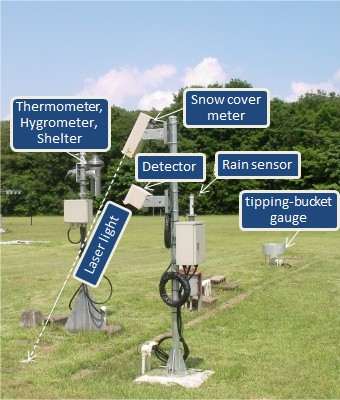
Observation field
JMA-10 surface meteorological observation equipment
The equipment consists of observational instruments and indoor storage units, a communication processor, a router and a monitor station. Non-barometer observational instruments are located on the roof of the observatory and on the observation field. The barometer is housed in an indoor storage unit and set up in the observation operating room with the communication processing unit.
(1) Instruments
The Aerological Observatory houses platinum resistance thermometer, electrical hygrometer, tipping-bucket gauge, rain sensor, electronic barometer, propeller vane, pyranometer, rotation-type sunshine duration meter, snow cover meter and visibility meter equipment.
(2) Indoor storage equipment
Indoor storage involves the use of a 19-inch rack (compliant with EIA standards) housing the communication processing unit and equipment including the signal conversion unit, the data communication unit and the power supply unit.
(3) Monitor station
The monitor station is a terminal for monitoring interactive data, applying various settings and creating unique registers.
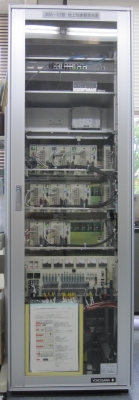
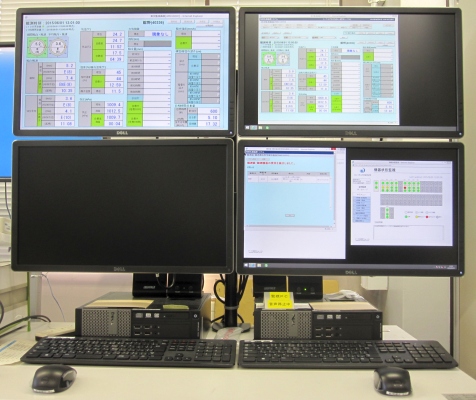
Indoor storage equipment (left) and monitor station (right)
Instruments
(1) Platinum resistance thermometer
The platinum resistance thermometer determines temperature based on heat-related changes in the electrical resistance of platinum, which is highly pure, ductile and chemically/thermally stable. The sensor is a thin plate made of porcelain or mica wound with platinum wire. It is fully waterproofed inside a corrosion-inhibiting stainless steel protective tube with high thermal conductivity.
To enable measurement of temperature and humidity outdoors, sensors need to be protected from the influences of solar radiation, wind and rain. Accordingly, JMA's temperature and humidity sensors are sheltered in a structure with two cylinders separated by insulating material to eliminate the effects of reflected light and solar radiation. The shelter also has a fan blowing at 4 - 7 m/s to keep solar radiation, wind and rain off the sensors.
(2) Electrical hygrometer
The sensor of an electrical hygrometer has a capacitor-like structure with a polymer membrane as an insulator. With this structure, changes in capacitance caused by variations in relative humidity are converted into electrical signals based on the hygroscopic characteristics of the polymer membrane.

Shelter
(3) Tipping-bucket gauge
Precipitation (rain or snow) falling in a 20-cm-caliber water collection container is discharged into a tipping bucket array through a funnel. The array features two buckets in the form of a seesaw; once rainwater corresponding to precipitation of 0.5 mm pools in one, it tips in the opposite direction and its water content is discharged. The amount of precipitation can be determined from the number of tips.
Precipitation is the amount of rain or snow that falls within a certain time (for rain, the depth the water would be if it remained on the ground without draining away; for solid precipitation such as snow, the corresponding depth of the melted equivalent).
The tipping-bucket gauge used in cold climates measures the amount of precipitation after melting it with a heater. This type (known as a hot-water rain gauge) is also used in winter at the Aerological Observatory.
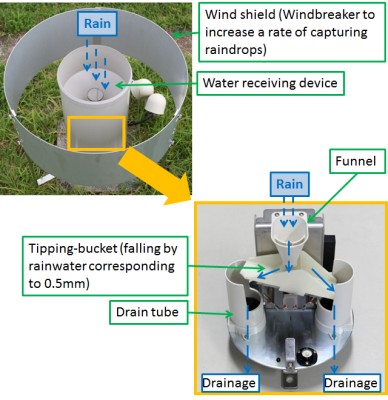
Structure of tipping-bucket gauge
(4) Rain sensor
The rain sensor surface is combed with printed electrodes to enable detection of precipitation-related energization. It measures 8 cm in diameter and has a conical form to promote drainage. The surface has a heater and a temperature sensor on its reverse side. When precipitation is detected, the unit outputs a pulse signal and accelerates rainwater evaporation with the heater.
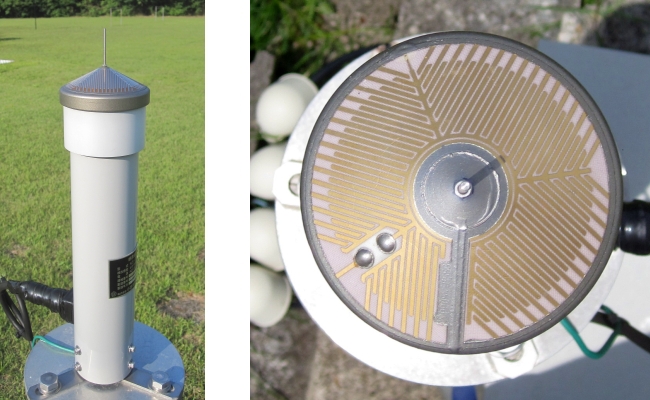
Rain sensor (left) and sensor surface (right)
(5) Electronic barometer
The sensor of the electronic barometer consists of a vacuum space with a thickness of 4 µm in a silicon substrate measuring 6 mm square and around 1.5 mm un thickness. Capacitance changes when atmospheric pressure variations cause displacement between the vertical electrodes of the vacuum, and the sensor detects these slight changes as electrical signals. This electrostatic capacity barometer houses a sensor, a conversion circuit and a processing circuit in a small plastic case. It measures atmospheric pressure continuously on a DC power supply and outputs the results as serial signals (RS-485).
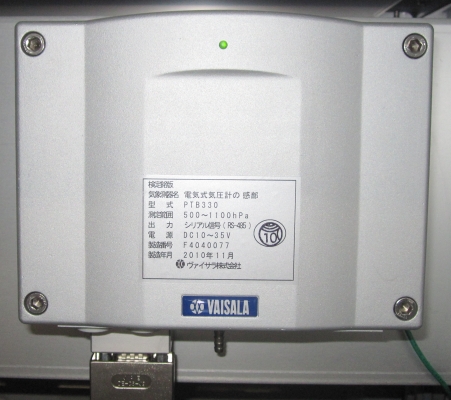
Electronic barometer
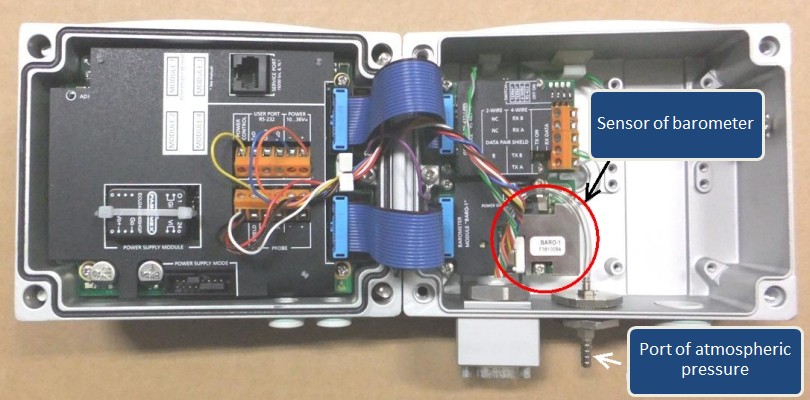
Inside the electronic barometer
(6) Propeller vane
The propeller vane has a four-blade propeller (called a windmill) at the tip of its streamlined body and a vertical tail at its rear, and is set on a column to allow free horizontal rotation. Wind speed is measured from the rotation speed of the windmill, which always faces windward, and wind direction is simultaneously determined from the orientation of the body.
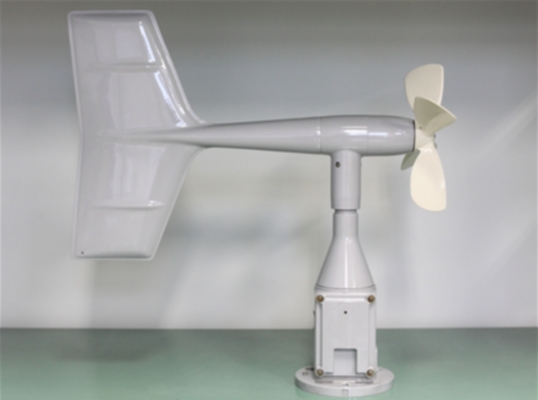
Propeller vane
(7) Pyranometer
The pyranometer has an electrically-insulated thermopile attached to two black sunlight-absorbing surfaces with different areas. These surfaces are housed in a glass dome to protect them from wind and rain and maintain a uniform temperature. The glass dome allows solar radiation with wavelengths of 0.3 - 3.0 µm (a range that covers most of the energy of such radiation) to pass through. A fan is attached to keep dust and frost off the dome. Solar radiation passing through the glass is absorbed by the surfaces and converted to thermal energy in proportion to its intensity, and the amount of solar radiation is thus determined.
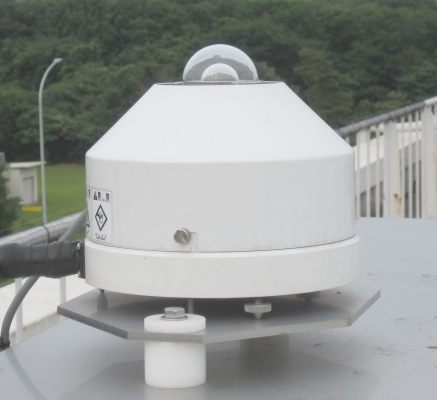
Pyranometer
(8) Rotation type sunshine duration meter
The rotation type sunshine duration meter has a scattering reflector that revolves once every 30 seconds along the main shaft (north-south) in a glass cylinder. It also has a feature to monitor this rotation. Sunlight reflected by the reflector hits a photosensitive pyroelectric element, and its irradiance is compared against a threshold sunshine duration of 0.12 kW/m2. A pulse signal indicating the presence of sunshine is output if the duration is greater than or equal to the threshold value.
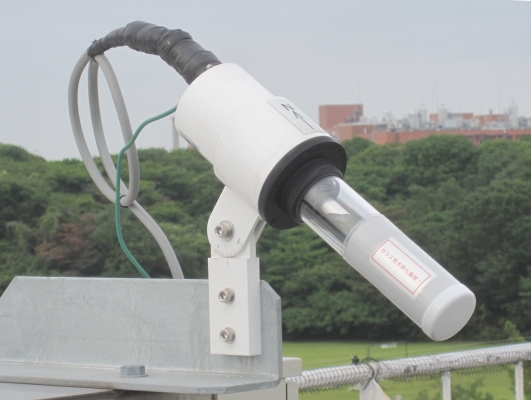
Rotation type sunshine duration meter
(9) Snow cover meter
The snow cover meter measures the phase difference between laser light it emits and that reflected by the snow cover surface. This difference is used to calculate the distance from the meter to the snow cover surface. The meter emits laser light every 10 seconds and outputs the distance to the snow cover surface as serial signals (RS-485). It is tilted about 30 degrees from the column to which it is attached to avoid unintended influence, and a snow-plate is placed on the snow cover surface. An infrared sensor is also used to detect motion; if a moving body is detected in the vicinity, laser emission is suspended for a certain period.
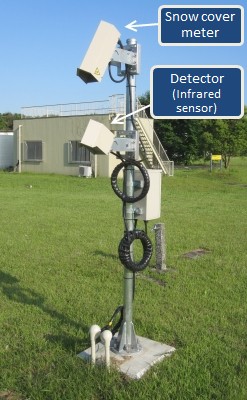
Snow cover meter